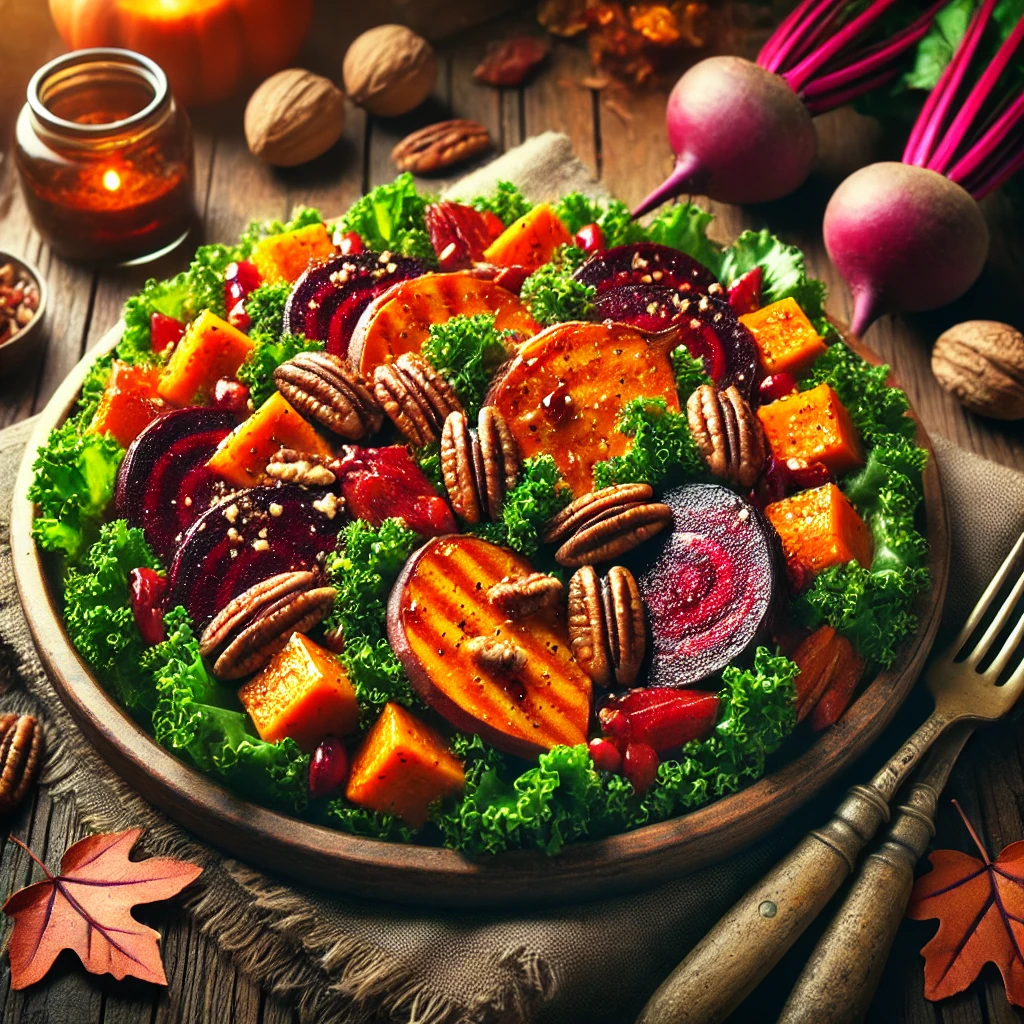As the leaves change color and temperatures drop, it’s the perfect time to embrace the vibrant and nourishing world of seasonal fall and winter salads. The crisp air and rich colors of autumn signal a transition, inviting us to indulge in the warmth of comfort foods while still prioritizing our health and well-being. These salads, rich in flavor and packed with nutrients, offer a delightful way to enjoy the bounty of seasonal produce while supporting a healthy, active lifestyle.
Imagine biting into a hearty salad filled with roasted root vegetables, tangy pomegranate seeds, and crunchy nuts, all drizzled with a zesty dressing that perfectly balances sweetness and acidity. These dishes not only tantalize your taste buds but also provide essential vitamins and minerals to fuel your body through the colder months. Whether you’re an avid fitness enthusiast, someone with an active lifestyle, or simply someone seeking to boost their wellness through nutritious eating, you’ll find that these salads can be both satisfying and invigorating.
In this article, we will guide you through a variety of autumn and winter salad recipes that celebrate seasonal ingredients. From comforting warm salads to fresh combinations bursting with flavor, there’s something here for everyone. We’ll also share tips for creating hearty salads that are not only delicious but also filling, ensuring that you stay energized and satisfied. Moreover, we’ll discuss the numerous benefits of incorporating these seasonal dishes into your diet, including improved digestion, enhanced mood, and better overall health.
So, if you’re ready to discover the endless possibilities of seasonal fall and winter salads, keep reading! Let’s embark on a journey of culinary exploration that will inspire you to savor the flavors of the season, transform your meals, and nourish your body—all while enjoying every delicious bite. Prepare to be motivated to whip up these vibrant dishes in your kitchen and share them with loved ones, creating moments of joy and connection around the table.

Table of Contents
Why Choose Seasonal Fall and Winter Salads?
Eating seasonally ensures you get the freshest, most nutrient-dense ingredients. Fall and winter salads feature:
- Rich in vitamins & fiber – Root vegetables like sweet potatoes, beets, and carrots provide essential nutrients.
- Comforting & satisfying – Warm roasted ingredients and protein-packed add-ins keep you full longer.
- Boosts immunity – Citrus fruits, nuts, and dark leafy greens enhance your immune system during colder months.
The Importance of Seasonal Eating
Before diving into specific recipes, it’s essential to understand the benefits of eating seasonally. Consuming foods that are in season not only enhances flavor but also maximizes nutritional value. Seasonal produce is typically harvested at its peak ripeness, meaning it retains more vitamins, minerals, and antioxidants. Additionally, seasonal eating supports local farmers and reduces the carbon footprint associated with transporting out-of-season foods.
In fall and winter, the produce available includes a rich variety of root vegetables, hearty greens, and citrus fruits. These ingredients not only provide essential nutrients but also help warm the body and enhance energy levels during the colder months.

Key Ingredients for Seasonal Salads
1. Root Vegetables
Root vegetables like sweet potatoes, beets, and carrots are excellent additions to salads during the fall and winter months. They are high in fiber, vitamins, and minerals, making them perfect for a hearty salad base. Roasting these vegetables brings out their natural sweetness and adds depth to your salads.
Example: Try a roasted beet and goat cheese salad topped with candied pecans for a delicious contrast of flavors and textures.
2. Hearty Greens
In colder months, leafy greens such as kale, spinach, and Swiss chard become more popular. These greens are nutrient-dense, packed with vitamins A, C, and K, as well as minerals like calcium and iron.
Example: A kale and quinoa salad can provide a satisfying meal rich in protein, fiber, and essential nutrients.
3. Seasonal Fruits
Incorporating seasonal fruits like apples, pears, and citrus can add natural sweetness and a burst of flavor to your salads. These fruits are typically at their best during the fall and winter, providing a refreshing contrast to the heartier ingredients.
Example: An apple and pomegranate salad with a maple vinaigrette is a festive option that’s perfect for holiday gatherings.
4. Nuts and Seeds
Adding a handful of nuts or seeds can elevate your salads by providing healthy fats, protein, and crunch. Ingredients like walnuts, pecans, and pumpkin seeds are excellent choices that complement the flavors of winter salads.
Example: A winter salad with spinach, walnuts, and feta cheese drizzled with a balsamic reduction is not only delicious but also nutrient-rich.
Creating Hearty Fall and Winter Salads
Tips for Building a Satisfying Salad
- Layering Flavors: Start with a base of greens and layer in roasted vegetables, fruits, nuts, and a flavorful dressing. This approach creates a balanced dish with varied textures and tastes.
- Choosing the Right Dressing: A good dressing can elevate your salad from ordinary to extraordinary. Opt for dressings made with seasonal ingredients, such as maple syrup, apple cider vinegar, or citrus juices.
- Add Protein: Incorporate protein sources like grilled chicken, chickpeas, or tofu to make your salads more filling. This addition is especially important for those with active lifestyles.
- Experiment with Warm Ingredients: Consider warming your salad by using roasted or sautéed ingredients. Warm salads can be incredibly comforting during chilly months.
Delicious Seasonal Fall and Winter Salad Recipes
1. Warm Quinoa and Sweet Potato Salad
This hearty salad combines roasted sweet potatoes with quinoa, spinach, and a tangy dressing. It’s perfect for a filling lunch or dinner.
Ingredients:
- 1 cup quinoa
- 2 sweet potatoes, diced
- 4 cups fresh spinach
- 1/4 cup feta cheese (optional)
- Olive oil, salt, and pepper for roasting
Instructions:
- Preheat the oven to 400°F (200°C).
- Toss sweet potatoes in olive oil, salt, and pepper, then roast for 25-30 minutes.
- Cook quinoa according to package instructions.
- In a large bowl, combine quinoa, roasted sweet potatoes, spinach, and feta. Drizzle with olive oil and toss to combine.
2. Autumn Harvest Salad
Celebrate the flavors of the season with this vibrant salad featuring apples, pomegranates, and roasted Brussels sprouts.
Ingredients:
- 4 cups mixed greens
- 2 cups roasted Brussels sprouts
- 1 apple, thinly sliced
- 1/2 cup pomegranate seeds
- 1/4 cup pecans, toasted
- Maple vinaigrette
Instructions:
- Roast Brussels sprouts in olive oil until golden and crispy.
- In a large bowl, combine mixed greens, Brussels sprouts, apple slices, pomegranate seeds, and pecans.
- Drizzle with maple vinaigrette and serve immediately.

3. Beet and Goat Cheese Salad
This colorful salad features earthy beets paired with creamy goat cheese and crunchy walnuts.
Ingredients:
- 4 cups arugula
- 2 cups roasted beets, sliced
- 1/4 cup goat cheese, crumbled
- 1/4 cup walnuts, toasted
- Balsamic vinaigrette
Instructions:
- Arrange arugula on a plate and top with sliced beets, goat cheese, and walnuts.
- Drizzle with balsamic vinaigrette and serve as an appetizer or side dish.
4. Chilly Weather Salad with Lentils
Packed with protein and fiber, this lentil salad is perfect for a filling meal on a cold day.
Ingredients:
- 1 cup cooked lentils
- 2 cups diced vegetables (carrots, celery, bell peppers)
- 1/4 cup red onion, diced
- 1/4 cup parsley, chopped
- Lemon vinaigrette
Instructions:
- In a large bowl, combine cooked lentils, diced vegetables, onion, and parsley.
- Drizzle with lemon vinaigrette and toss to mix.
5. What foods are OK to eat cold?
When you’re short on time or energy, you might wonder: What foods are OK to eat cold? The good news is that many nutritious options don’t require heating—and some even taste better chilled. According to BBC Good Food ME and WebMD, certain cold foods can be just as satisfying and healthy as warm meals.
So, what foods are OK to eat cold without sacrificing flavor or nutrition? Here’s a breakdown of the best options:
1. Fresh Fruits & Vegetables
- Crunchy veggies (carrots, cucumbers, bell peppers) with hummus
- Fruit salads (berries, apples, grapes) for natural sweetness
- Leafy greens (spinach, kale) in cold salads
2. Protein-Packed Choices
- Greek yogurt (high in probiotics for gut health)
- Hard-boiled eggs (ready-to-eat protein)
- Canned tuna or salmon (great for quick salads or sandwiches)
3. Grains & Legumes
- Quinoa or couscous salads (toss with veggies and vinaigrette)
- Chickpeas or lentils (perfect for cold bean salads)
4. Dairy & Alternatives
- Cheese slices or cubes (pair with whole-grain crackers)
- Cottage cheese (top with fruit for a balanced snack)
5. Pre-Cooked & Ready-to-Eat Meals
- Sushi rolls (packed with omega-3s)
- Cold pasta salads (use whole-wheat noodles and olive oil dressing)
What foods are OK to eat cold when you’re sick? WebMD recommends soothing options like:
- Chilled applesauce (easy on sore throats)
- Frozen banana slices (helps with hydration)
- Cold smoothies (blend yogurt, fruit, and honey)
6. Which Vegetables Are Good for a Cough?
When that nagging cough won’t quit, you might ask: Which vegetables are good for a cough? Turns out, Mother Nature’s pharmacy offers powerful options. According to Tata AIG and Prospan, certain vegetables can soothe irritated throats, reduce mucus, and boost immunity.
So which vegetables are good for a cough specifically? Here are the top healing picks:
1. Garlic & Onions (Nature’s Antibiotics)
- Contain allicin with antiviral/antibacterial properties
- Best consumed raw in honey infusions or cooked in broths
2. Ginger (The Cough Calmer)
- Reduces throat inflammation
- Enjoy grated in tea or blended into soups
3. Pumpkin & Sweet Potatoes
- High in vitamin A to repair respiratory tissues
- Roast or puree into soothing soups
4. Leafy Greens (Kale, Spinach)
- Packed with vitamin C and antioxidants
- Lightly steam to preserve nutrients
5. Radishes & Horseradish
- Natural decongestants that break up mucus
- Add thin slices to salads or teas
Which vegetables are good for a cough when you need immediate relief? Try this:
- Honey-roasted carrots (soothes scratchy throats)
- Leek and potato soup (reduces chest congestion)
For persistent coughs, Prospan recommends avoiding mucus-producing vegetables like tomatoes and eggplants. Instead, focus on the above options paired with warm herbal teas.
7. What is the best salad for winter?
When chilly weather hits, you might wonder: What is the best salad for winter? The answer lies in hearty, warming ingredients that balance nutrition and comfort. According to Love & Lemons, the best winter salads combine roasted vegetables, robust greens, and bright dressings to beat the cold-weather blues.
Here are 3 top contenders for the best salad for winter, packed with seasonal flavor and immune-boosting benefits:
1. Roasted Delicata Squash & Kale Salad (The Ultimate Winter Comfort)
Why It’s the Best:
- Sweet roasted squash caramelizes naturally, needing no peeling
- Crispy chickpeas add plant-based protein and crunch
- Massaged kale stays sturdy without wilting
- Apple cider vinaigrette ties it all together
Perfect For: Anyone asking “What is the best salad for winter?” who craves sweet-savory balance.
2. Beet, Citrus & Farro Salad (A Vitamin C Powerhouse)
Why It’s the Best:
- Roasted beets (pre-cooked for convenience)
- Blood oranges and grapefruit for peak-season citrus zing
- Chewy farro adds whole-grain heartiness
- Hazelnuts for crunch and healthy fats
Perfect For: Those seeking the best winter salad to boost immunity with vibrant colors and textures.
3. Warm Brussels Sprouts & Pomegranate Salad (Holiday Showstopper)
Why It’s the Best:
- Charred Brussels sprouts (roasted or pan-seared)
- Jewel-like pomegranate seeds for antioxidants
- Creamy goat cheese melts slightly on warm sprouts
- Maple-tahini dressing for cozy sweetness
Perfect For: Answering “What is the best salad for winter?” with a festive, company-worthy dish.
Why These Are the Best Winter Salads
- Embrace seasonal produce (squash, citrus, root veggies)
- Mix warm + cold elements for comfort and freshness
- Prioritize texture contrasts (creamy, crunchy, chewy)
Frequently Asked Questions (FAQ)
1. What are some easy fall salad ideas?
Some easy fall salad ideas include roasted squash salads, apple and walnut salads, and kale salads with cranberries and feta. These options are not only simple to prepare but also highlight seasonal flavors.
2. How can I make a winter salad more filling?
To make a winter salad more filling, consider adding protein sources such as grilled chicken, chickpeas, or quinoa. Incorporating roasted vegetables and grains can also enhance the heartiness of your salad.
4. What are some seasonal harvest salads?
Seasonal harvest salads often include a mix of roasted root vegetables, hearty greens, nuts, and seasonal fruits. Examples include beet and goat cheese salads, winter citrus salads, and apple and pomegranate salads.
5. Is salad good during a cold?
When you’re sniffling and sneezing, you might wonder: Is salad good during a cold? The answer is a resounding yes – if you build it right. According to Midland Health, the key lies in choosing ingredients that actively boost your immune system while being gentle on your throat.
So is salad good during a cold when compared to traditional comfort foods? Research shows that dark leafy greens like spinach and kale provide essential vitamins A, C, and K that your body craves when fighting infection. But the real question isn’t just is salad good during a cold, but what kind of salad?
The best cold-fighting salads include:
- Citrus segments (for a vitamin C punch)
- Thinly sliced ginger (natural antiviral properties)
- Toasted walnuts (zinc for immune support)
- Light honey-lemon dressing (soothes throats)
Is salad good during a cold if you have a sore throat? Absolutely – just avoid rough, scratchy ingredients like raw broccoli or thick cabbage. Instead, opt for tender greens and roasted vegetables that go down easy.
For those still wondering is salad good during a cold, consider this: a nutrient-dense salad combined with warm herbal tea or broth gives you both the vitamins you need and the comfort you want. It’s the ultimate cold-weather wellness hack.
Conclusion
As we embrace the cozy months of fall and winter, let’s celebrate the delicious and nutritious options available in seasonal fall and winter salads. These salads not only nourish our bodies but also provide a wonderful opportunity to enjoy the flavors of the season. By incorporating hearty ingredients, vibrant fruits, and wholesome dressings, you can create satisfying dishes that support your active lifestyle and overall wellness.
Whether you’re preparing a festive winter salad for a holiday gathering or simply looking for comforting fall salads to enjoy at home, the possibilities are endless. Let your creativity shine as you explore the world of seasonal salads, and remember to embrace the goodness that comes with eating in harmony with nature. Enjoy your journey into the world of seasonal salads for cold weather, and savor every delicious bite!
you may also like:
What should I do immediately after running? A Complete Guide to Post-Run Recovery
Mediterranean Salad Recipes: A Fresh Path to Health, Flavor, and Joy
Salad Recipes for Weight Loss: The Ultimate Guide to Healthy Eating and Wellness
Unlock the Benefits of Salad: Nutritional Power for Health, Wellness, and Active Living
High Protein Salad Recipes: The Perfect Fit for Health and Active Lifestyles
More relevant articles here >>>
More Health and Wellness Salad Recipes >>>
More Energy and Active Lifestyle Salad Recipes >>>
More Cultural and Seasonal Recipes >>>
references:
“Nutritional Differences Between Seasonal and Non-Seasonal Produce” (Journal of Agricultural and Food Chemistry, 2013)
“Root Vegetables and Their Role in a Healthy Diet” (Nutrients, 2018)
“The Role of Temperature in Food Satisfaction” (Appetite, 2015)




